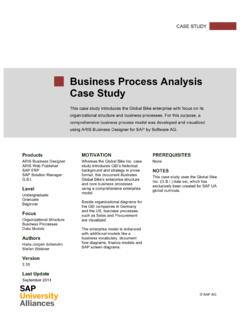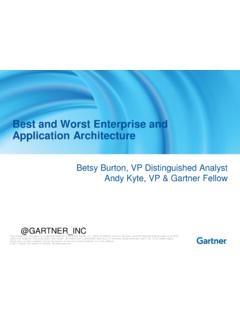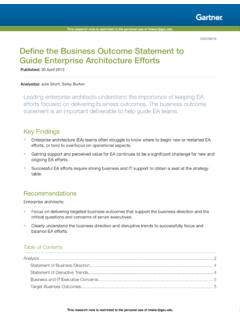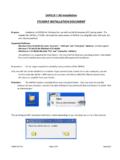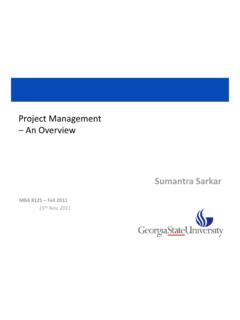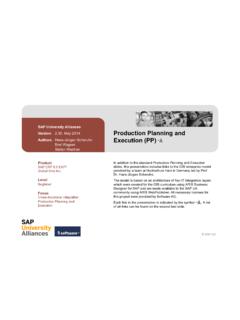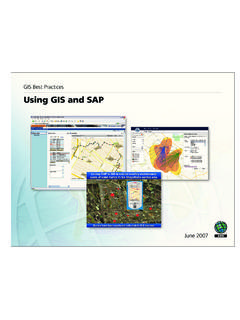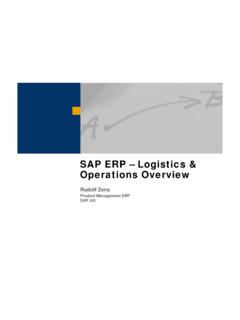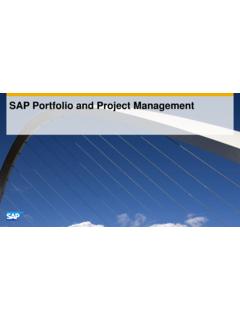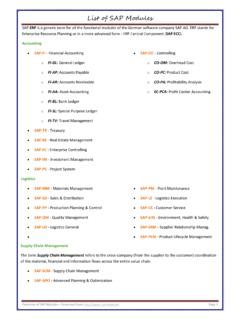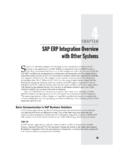Transcription of Stefan Weidner Financial Accounting (FI)
1 Financial Accounting (FI)SAP University AlliancesAuthors Bret WagnerStefan WeidnerProductSAP ERP EhP7 Global Bike integrationgFinancial Update SAP AGLast UpdateMay 2014 SAP ERPC ourse Overview Introduction to SAP Navigation Navigation Introduction to GBI Sales & Distribution Materials Management Production Planning Financial Accounting Controlling Human Capital Management Warehouse ManagementPage 7-2 Project SystemSAP ERPUnit Overview FI Organizational Structure FI Master Data FI Master Data FI Processes FI Reportingpg Audit TrailsPage 7-3 SAP ERPGoal of Financial Accounting (FI) Financial Accounting is designed to collect the transactional data that provides a foundation for preparing the standard portfolio of reports. In general, these reports are primarily, but not exclusively, directed at external Standard reports include:- Balance SheetISttt-Income Statement- Statement of Cash FlowsPage 7-4 SAP ERPT arget Audience Internal- Executives External- Legal Authorities- Senior Management- Administrative Staff- Employees- Banks- Auditors- Shareholders- Insurance- Taxing Authorities- Media- Financial AnalystsPage 7-5 SAP ERPFI Organizational Structure Represents the legal and/or organizational views of an enterprise Forms a framework that supports the activities of a business in the Forms a framework that supports the activities of a business in the manner desired by management Permits the accurate and organized collection of business iftiinformation Supports the development and presentation of relevant information in order to enable and support business decisionsPage 7-6 SAP ERPFI Organizational Structure Client- An independent environment in the system Company Code- Represents an independent legal Accounting unit- Balanced set of books.
2 As required by law, are prepared at this A client may have more than one company code United States Germany United Kingdomg Australia ..Liabilities &Owners EquityAssetsOwners EquityPage 7-7 SAP ERPFI Organizational Structure Chart of Accounts- A classification scheme consisting of a group of general ledger (G/L) accounts- Provides a framework for the recording of values to ensure an orderly rendering of Accounting data - The G/L accounts it contains are used by one or more company tlA Credit Control Area- An organizational entity which grants and monitors a credit limit for It can include one or more company codesBiA Business Area- An organizational unit that represents a separate area of operations or responsibilities within an organization and to which value changes recorded in Financial Accounting can be allocated- Financial statements can be created for business areas, and these statements can be used for various internal reporting 7-8 SAP ERPGBI Structure for Financial AccountingGlobal BikeClientGlobal Bike Bike Germany GmbHCompanyCodeGlobal Bike Chart of AccountsChart ofAccountsBikesBusiness AreaCredit ControlAreaGlobal Credit ControlPage 7-9 SAP ERPGBI enterprise Structure in sap erp ( Accounting )
3 Business Area Bikes BI00 CompanyCodeCC( )GChart of Accounts (global) GL00CC US00CC DE00 Controlling Area(see Controlling unit)Operating Concern(see Controlling unit)Operating Concern (global) GL00CA Europe EU00CA North Am. NA00CA Asia AS00 Credit Control Area (global) GL00 Page 7-10 Client GBISAP ERPFI Master Data General Ledger (G/L) Accounts - The unique combination of Company Code and Chart of Account creates a data storage area called a General The General Ledger contains a listing of the transactions effecting each account in the Chart of Accounts and the respective account It is utilized in the preparation of Financial Accounting 7-11 SAP ERPFI Master Data Customer and Vendor Master Data- Customer and vendor account balances are maintained in FI through fully i tt dti bldtblbdlintegrated accounts receivable and accounts payable Financial postings for customers and vendors are made directly to their respective individual accounts and accompanied by a concurrent automatic posting to the General 7-12 SAP ERPC ustomer Accounts Accounts Receivable Sub-Module (FI-AR)
4 - Information with respect to customers who purchase the enterprise s goods and ihld tdservices such as sales and payments made- Substantive and important integration between Sales and Distribution (SD) and Financial Accounting (FI)- Billings in SD generate FI journal entries for sales activity ggjyAccounts Receivable(General Ledger)300 Customer 142100 Customer 189(General Ledger)950 Customer 123 Customer 135150 Customer 123400 Customer 135 Page 7-13 SAP ERPV endor Accounts Accounts Payable Sub-Module (FI-AP)- Information with respect to Vendors from whom the enterprise purchases goods dihhdtdand services such as purchases and payments made- Substantive and important integration between Materials Management (MM) and Financial Accounting (FI)- Purchase and goods receipt activities in MM generate FI journal entries gpg jAccounts Payable(General Ledger)250 Vendor 100435200 Vendor 100234(General Ledger)850 Vendor 100621 Vendor 100846100 Vendor 100621300 Vendor 100846 Page 7-14 SAP ERPFI Processes Posting a G/L EntryPage 7-15 SAP ERPFI Reporting G/L Account SummaryPage 7-16 SAP ERPFI Reporting Balance Sheet - Presentation of an organization s Assets, Liabilities, and Equity at a point in time- Assets: What the company owns- Liabilities: What the company owes- Equity.
5 The difference between Assets and Liabilities- Assets = Liabilities + EquityPage 7-17 SAP ERPFI Reporting Balance Sheet ExampleAssetsCash1,000 Accounts Receivable3,000 Eit500 LiabilitiesAccounts Payable1750 Taxes Payable500T t l Li biliti2 250 Equipment500 Total Assets4,500 Total Liabilities 2,250 EquityCommon Stock2,000,Retained Earnings250 Total Equity2,250 Total LiabilitiesTo t a l Liabilities and Equity4,500 Page 7-18 SAP ERPFI Reporting Income Statement - Presentation of an organization s revenues and expenses for a given period of time ( monthly, quarterly, or yearly)- Revenues, in a simple sense, are inflows of cash as a result of selling activities or the disposal of company Expenses, in a simple sense, are outflows of cash or the creation of liabilities to support company Revenues - Expenses = Net IncomePage 7-19 SAP ERPFI Reporting Income Statement ExampleRevenueSales11,000 Deductions750 Total Revenue10 250To t a l Revenue10,250 Operating ExpensesCost of Goods Sold4,500 Operating Expenses3,750 Total Expenses8,250 Net Income Before Taxes2 000 Net Income Before Taxes2,000 Taxes750 Net Income1,250 Page 7-20 SAP ERPFI Reporting Statement of Cash Flows- Considers the associated changes, both inflows and outflows, that have occurred in cash arguably the most important of all assets over a given period of time ( monthly, quarterly, or annually)
6 Page 7-21 SAP ERPA ccountants and Audit Trails Audit trails allow an auditor to begin with an account balance on a Financial statement and trace through the Accounting records to the transactions that tthtb lsupport the account balance. Audit trails enable an auditor to trace individual transactions to the effected account balance(s) on a Financial 7-22 SAP ERPSAP Document Principle Each business transaction impacting FI writes data to the SAP database creating a uniquely numbered electronic document. The document number can be used to recall the transaction at a later date. It contains, for example, such critical and necessary information as:-Responsible personpp- Date and time of the transaction- Commercial content Once written to the SAP database, a Financial document (one impacting theOnce written to the SAP database, a Financial document (one impacting the Financial position of the company) can not be deleted from the database. It can be changed to some degree.)
7 Th SAP dti i lidlidd itt fk f The SAP document principle provides a solid and important framework for a strong internal control system a requirement of law for companies that operate in the United States and in most other countries in the 7-23 SAP ERPSAP Document PrinciplePage 7-24 SAP ERPSAP FI Module Fully integrated with other SAP modules including, but not limited to:- Sales and Distribution (SD)- Materials Management (MM)- Production Planning and Execution (PP)- Managerial Accounting (CO)Page 7-25
